The village is so winding and steep, clinging stubbornly to the mountainside, that it looks as if it was built along a mule-track. It couldn’t be described as beautiful but it has a lively, friendly atmosphere.
The Church of San Giovanni Battista
is worth a visit: over the last half-century, the parish priest has been responsible for transforming an ordinary church of the Latin rite into an Orthodox church whose every surface is covered with mosaics by Biagio Capparelli, a local artist. They show an interesting fusion of the most solemn Byzantine canons with lively episodes from contemporary spiritual life – a portrait of Mother Teresa of Calcutta, for example – or with decorative motifs that are wholly modern. The sight is overwhelming: it’s like going into a glittering Ali Baba’s cave of the sacred. There is a tiny, richly decorated chapel which is also interesting: it has a wonderful wooden painted ceiling and a large collection of old wooden anthropomorphic reliquaries, which come from a ruined monastery nearby.
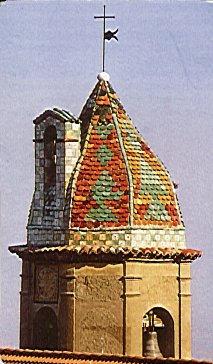
In this beautiful and well-preserved little town - described in the tourist literature as ‘Calabria’s Spoleto’- it’s a real pleasure to stroll through the streets, relax in the cafes or wander round the little shops selling old things from ‘times past’. The following are worth a visit: the medieval Castle, with its delightful, unspoilt little rustic courtyard; the Museo di Arte Sacra (Museum of Sacred Art) in the Dominican monastery where the tempestuous Tommaso Campanella was a student; and above all the Church of Santa Maria della Consolazione.
This magnificent building, with its simple, elegant outlines, dates from the Angevin period and reflects the taste for French Gothic. In the partly baroque interior, there are works by Simone Martini and Bartolomeo Daddi together with some fifteenth-century paintings. The fourteenth-century tomb of the great feudal lord Filippo Sangineto is particularly beautiful. Also outstanding are the Sanseverino family monuments and the great tombstone of the Ruffo family. It’s a small pantheon of Calabria’s most illustrious and powerful feudal families, gathered together en famille in this architectural gem.
The steep little streets, the simple restaurants set up in the vast entrance halls or the stables of elegant palazzi, the discreet street lighting, the magnificent views glimpsed from every corner, the stone buildings, the kindly and courteous inhabitants, the glimpses of women engaged in lace-making and embroidery behind the shutters or gathered in the ground-floor rooms – all this makes Altomonte a delightful place at any time of year, not only during the tourist season.
old calabria recommends:
Hotel Barbieri, via San Nicola 30.
È l'albergo storico del paese, collocato in bella posizione su un ampio anfiteatro naturale tra il Pollino e la Sila. Aperto tutto l'anno, dispone di trenta camere funzionali con aperture su panorami magnifici.
Il Castello di Altomonte, piazza Castello 6
Piccolo albergo di charme alloggiato nell'antico castello normanno, proprio al centro del vecchio borgo medievale. Gli ambienti, sapientemente restaurati, rendono l'atmosfera accogliente e familiare. Bellissimi gli affreschi, databili alla fine del XVI secolo, e gli arredi. Aperto tutto l'anno, dispone di undici camere, arredate con gusto e sobrietà.
Al Ristoro del Principe, Palazzo Pancaro
L'offerta è di ottima qualità, come pure l'accoglienza. Buonissimi gli antipasti (si consiglia la cianfotta di uova strapazzate e salsiccia) e la zuppa di fagioli. Ottimo il gelato con la salsa di cioccolato. Ampia la scelta dei vini.
Bottega di Casa Barbieri, Via L. Sparano 3
Ricchissimo il repertorio dei prodotti alimentari dell'antica tradizione calabrese da assaggiare e acquistare: olio, vino, liquori, infusi, marmellate, miele, conserve, formaggi, insaccati, funghi, ecc.
Gran Caffè Città del Sole, piazza Duomo
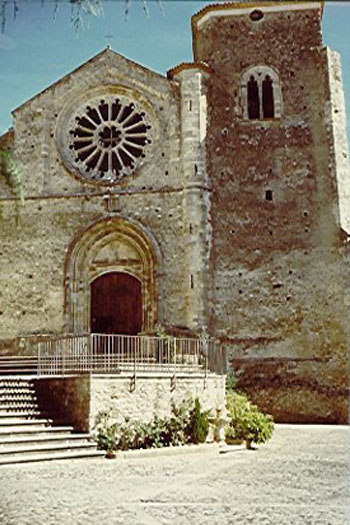
Former fief of the extremely powerful and turbulent Sanseverino family. Until a few years ago, it was a centre for highly skilled craft workers. We go through it in order to visit the Abbazia della Sambucina, set deep among the oleanders. Once a celebrated, powerful monastery, the abbey is today merely an imposing ruin. This majestic, solitary spot is imbued with all the ‘poetry of ruins’. Even the profound silence that reigns here has the eloquence of a solemn warning.
old calabria recommends:
Antica Liuteria De Bonis, Via Giudeca 39
L'ultimo discendente di una famiglia storica di liutai,
che costruisce antichi strumenti musicali calabresi.
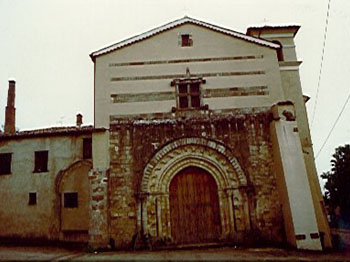
We visit its imposing medieval castle, which was restored in the nineteenth century somewhat in the style of Viollet-le-Duc. The owners still live there and the castle can be visited on request. It stands high up on a rocky outcrop with a rocaille effect, with massive high overhanging walls. Its pretty walled garden is now a small, rather run-down municipal park. The coup de théâtre, however, is the breathtaking panoramic view from the top of the proud, low ensign tower jutting out above the beautiful roofs of rough old tiles.
Also worth a visit are the Cappella Cavalcanti (Cavalcanti Chapel) belonging to the Order of the Knights of Malta and the beautiful church known as the Chiesa della Riforma, which has some splendid examples of the gilded or painted carved wooden altars, choirs, choir-stalls, pulpits and thrones that are typical of the mountain areas of Calabria. These unpretentious and patiently executed works are remarkably elegant, their gold now glazed over with time, their colours faded and toned down

"And now the ‘enchanted forest’, the ‘magic plateau’, the ‘great wood’ of antiquity awaits us – we are heading for the Sila! The visitor is immediately struck by the splendid alternation of wooded and cultivated land. It is almost like being in a vast garden where brilliant green or golden-yellow lawns are surrounded by densely planted borders on a monumental scale!" - Norman Douglas
Camigliatello Silano is the headquarters of the Literary Park. They are situated here in a historic building known as the Torre (tower) di Camigliati, surrounded by luxuriant countryside that has been tended since time immemorial. Travellers who cross the Sila experience the childish bewilderment of someone who leaves a cosy refuge and faces the deep, dark shadows of a wood that may be enchanted or bewitched. The great silhouettes of the pine-trees stoop lovingly over the Sila’s magnificent roads like an unsleeping, silent army.
The roads, which are deserted at night, afford sudden sweeping glimpses of pasture land or fields of wheat, punctuated by the occasional outline of dimly lit rustic dwellings or wooden chalets. These reawaken in the traveller those fairy-tale emotions of fear and excitement that seemed to have been lost way back in childhood. These ‘re-immersions' into long-forgotten periods of one's life are among the most rare and precious gifts that a journey can bestow!
old calabria recommends:
Hotel Ristorante Aquila Edelweiss, Viale Stazione 15
È l'albergo storico del paese, frequentatissimo durante la stagione invernale. Ricchissima la cucina, una delle migliori della Calabria, tutta a base di prodotti locali e di stagione. Ottime i funghi e le carni. Molto buoni i formaggi e i frutti di bosco. L'ambiente è piacevolissimo ed accogliente.
La Tavernetta, di Pietro Lecce, Contrada Campo San Lorenzo tel. 0984/57.90.26.
Le Tre Lanterne Ristorante, di Francesco Montalto, Via Roma, 142 - tel. 098/578203
La Locomotiva, servizi per il turismo, di Angela Caligiuri,
Contrada San Nicola Silvana Mansio, tel. 0984/57.98.03.
Blu Calabria, servizi per il turismo, di Silvio Manna, Via dei Garofani, 2 Trenta (Cs)
tel. e fax 0984/43.98.80 - sito: www.blucalabria.it - e.mail: blucalabria@libero.it.

The most famous archaeological site near Crotone. Here, at the easternmost point of Calabria – with that unerring genius for choosing sites of symbolic significance that was typical of the civilization of Magna Graecia – stood the imposing, venerated and extremely rich Sanctuary of the Lacinian Hera (Hera Lacinia) in its sacred grove. Only one of the ancient temple’s forty-eight columns remains, standing in lonely majesty against the backdrop of a Homeric, almost black sea.
Capo Colonna’s immense fame throughout the ancient world, its brutal despoliation and the heart-rending testimony of its one remaining column, which seems almost to be pleading, have drawn travellers like pilgrims down the centuries.
It has inspired a whole set of exquisite literary variations, ranging from the melancholic right through to the most picturesque flights of fancy. This would seem the appropriate moment for a meditative halt and some reflections on the precarious nature of human greatness. Nowadays it is literature alone that can impart such solemn moral lessons – when they come richly clothed in an eloquent literary style, the traveller does not reject but welcomes and absorbs them.
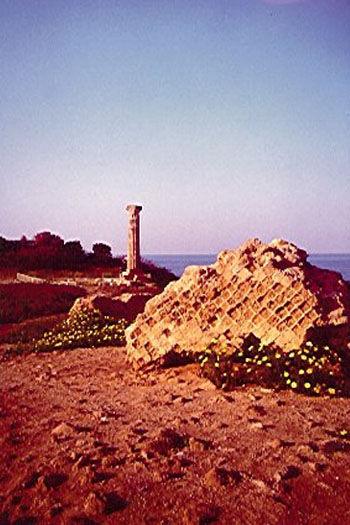
L'antica Cossa, edificata nel IX secolo su un anfiteatro naturale al limite della fascia che separa la piana di Sibari dal Pollino, e distrutta dai Crotoniati insieme alla vicina Sibarys. Nella parte bassa dell'abitato da visitare la Cattedrale, di origine bizantina ma ricostruita nei secoli XV e XVI e completamente rifatta sul finire del XVII secolo. All'interno sono ancora ben visibili tracce degli affreschi quattrocenteschi che ornavano le pareti.

The tiny village of Castelsilano stands on a steep hillside. We can stop here briefly to admire the modern murals by a local artist – Franco Candido - on the facades of some of the buildings. The work resembles a Via Crucis which commemorates a now-vanished ancient local identity, but it also shows a justified pride in craftsmanship and acts as a small visual ‘encyclopaedia’ of the life of a community.
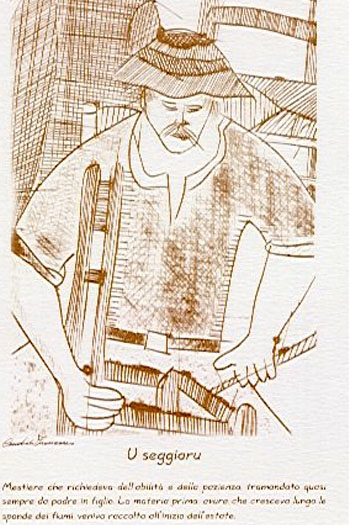
A small but delightful historic centre. First we visit the recently restored Protoconvento Francescano, with its two beautiful adjoining cloisters which house an elegant lapidarium (museum of epigraphy), its vast halls and covered passageways, and the questionable addition of a modern theatre. As always, there is a magnificent view.
Next to the great Franciscan building stands an Aragonese castle which dominates the little square good-naturedly; unchanged and well loved, with a slightly tumbledown air, it adds a lovely scenic touch. Little by little, the tangle of weeds sprouting from the facade, together with the rather dilapidated courtyard, have turned a grim castle into a country house!
Other places to visit at Castrovíllari are the very early basilica of Santa Maria del Castello and the small Museo Civico (town museum).
The area around Castrovíllari has many villages of Albanian origin. They were established in the fifteenth century when the Albanians, after the death of their hero–king George Castriota Skanderbeg, took refuge from the mighty Ottoman advance by fleeing towards the Italian coast.
old calabria recommends:
La Locanda di Alia, Via Jetticelle 55
Il più celebre ristorante calabrese, famoso per i suoi squisiti menus che aprono l'antica cucina regionale al gusto della nouvelle cuisine. L'ambiente, nella sua sobrietà, è elegante e raffinato. Ottima scelta di vini.
La Torre Infame, Largo Castello 16
Ambiente semplice ma elegantemente curato, con buona scelta di vini.
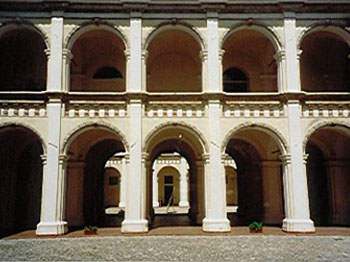
It is an hospitable and little village, a former fief of the Pignatelli family. We visit the spectacular Santuario (shrine) di Santa Maria delle Armi. This fifteenth-century monastic building, which was heavily altered in the eighteenth century, seems to jut out from the face of a huge rocky pinnacle like a high-relief. With magnificent scenery all around, it looks out over a limitless panorama of valleys and mountains. The shrine itself is a little temple, with the oriental atmosphere and clutter typical of Orthodox churches. The objects come from the most varied sources and eras, yet make a wonderfully harmonious blend, literally creating a beautiful ‘house of God’. Every item in this isolated gem of a church – the naïf fresco of the Last Judgement, painted in sombre colours; the little chapel of the Madonna, like a domed arbour adorned with marble of every conceivable colour; the altar silver; the rhetorical inscriptions on the tombstones; the tender faded fragments of frescoes of the Virgin Mary; the finely carved eighteenth-century confessionals; the ornate tracery of the old iron railings and gates – speaks of the civilization of Old Calabria.
old calabria recommends:
Locanda Il Campanile, Via A. Caputi
Locale semplice e molto curato. Piatti tipici con antichi sapori.
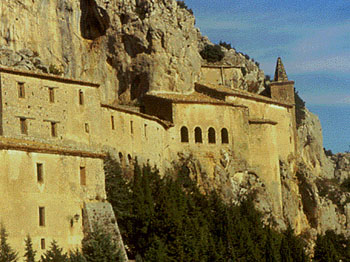
The nearby village of Cirò is interesting because of its intricate and compact urban layout and the remains of its fifteenth-century walls.

A few kilometres from Frascineto, we come to Cívita , a small and well-preserved village perched high up on a cliff. The air is rarified and pure and it is worth pausing a while in the little square, which is orderly and clean. It is flanked on all sides by small palazzi, their roofs adorned with old chimney-pots of imposing size and in a great variety of styles. There is a small Museo Etnico di Cultura Materiale Albanese (Ethnic Museum of Albanian Material Culture), which, though very simple, is lively and well-displayed. Also on the square is a church with the traditional iconostasis of the Eastern rite: it is modern but in good taste.
On leaving the village, we take a road going right through a wonderful grove of age-old olive trees. This leads to some high ground from where there is a breathtaking view over the Gole del Raganello . The sight of the Mediterranean scrub in full spring bloom on the slopes hardly diminishes the sense of the ‘Awesome' and the ‘Sublime' which the precipice arouses in the traveller. The bottom of the gorge can also be reached by means of a precipitous path along the side of the ridge.
The Vallje
The Vallje is a Typical folk-dance on the Tuesday after Easter.
old calabria recommends:
Ristorante Kamastra, Piazza Municipio, Tel. 0981/73.387
Realizzato nei locali di una vecchia filanda, offre prodotti tipici della cucina calabro-albanese. Rigorosissima la ricerca culinaria, attenta anche all'innovazione. Da assaggiare la pasta fatta in casa con "nenez" (erba della famiglia delle ortiche) e i "krustuli", dolci tipici albanesi.
Ristorante Pizzeria Agorà, Piazza Municipio, tel. 0984/73.410.
Piccolo locale confortevole ed accogliente, con una buona offerta di piatti tipici della più antica tradizione locale.
B&B il Belvedere, Via Cavallotti 27, tel e fax. 0981/73232 - cell. 349/0596417- 349/1297154
Sorge nella parte più panoramica di Civita, su una terrazza che si affaccia sulle Gole del torrente Raganello, uno degli scorci più spettacolari del Parco Nazionale del Pollino. Ricavato dalla ristrutturazione di un'antica abitazione, conserva intatta tutta la calda atmosfera delle case di un tempo.
info: ilbelvedere@bebparcodelpollino.it
web site: www.bebparcodelpollino.it
Cooperativa S.I.L.V.A., servizi per il turismo, di Giuseppe Lanza, tel. e fax 0981/489.687
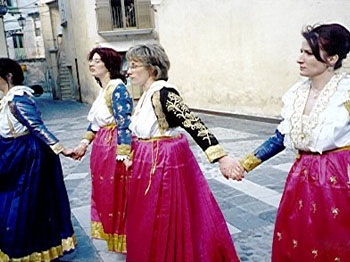
Corigliano Cálabro stands sentinel looking out over Sybaris . It enjoys a spectacular natural setting and there are still traces of the turbulent history of this feudal possession, whose wealth led to it being greatly coveted. The pride of Corigliano's old centre are the over-restored fifteenth-century castle, which initially belonged to the Ruffo family, then to the Saluzzos from Genoa and finally to the Compagnas, and a number of eighteenth-century churches. From the top of the castle, there is a fine view looking right out over the town's grey-green tiled roofs and, far away in the distance, the green of the countryside, ranging from silvery to dark hues and punctuated at regular intervals by old brick chimneys.
old calabria recommends:
Associazione Amici del Castello,servizi per il turismo, Presidente Enzo Viteritti, Via Principe Umberto, 7
tel 0983/82.264, fax 0983/88.53.07.
Società Cooperativa Il Serratore, Presidente Enzo Viteritti, Viale Rimembranze, 52 - tel. 0983/82.983 fax 0983/82.145
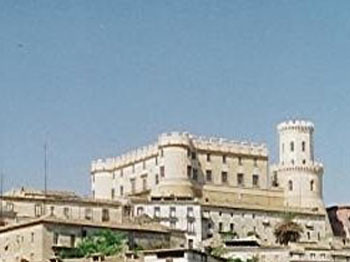
Our trip to Cosenza can be fitted in at any point along the itinerary. The watchword here is liveliness and cheerfulness. The city is an energetic, bustling and good-humoured place – the overall mood is optimistic and welcoming. The historic centre, which covers a large area, manages to be both imposing and full of life at the same time. The long period of neglect has degraded but not radically altered it; if the restoration work avoids excessive concrete and uniformity, the old quarter will re-emerge in all its splendour. There are several things to visit: the massive and particularly fine thirteenth-century Duomo ; the Teatro Rendano (Rendano Theatre); the shops along Corso Telesio ; the Casa delle Culture (a centre for activities relating to the city's rich cultural history); and – why not? – the rather old-fashioned patisseries (but isn't having a sweet tooth in itself rather old-fashioned and démodé ?); the restaurants, which are high-class but not snobbish; the wine bars, where you can find new drinks and dishes made with traditional ingredients; the bookshops where people also gather to meet and talk; and finally the Museum in the restored Palazzo Arnone and the NormanCastle .
old calabria recommends:
Antico Caffè Renzelli, Via Molinella, 15/B tel. 0984/27.005
Storico locale, aperto dal 1803. L'atmosfera che vi si respira è quella, piacevolissima e al tempo stesso raccolta e discreta, del salotto letterario
Calabria Bella, piazza Duomo, 20 tel. 0984/79.35.31
Wine Bar Doc, Vico San Tommaso 13, tel. 0984/73.110
Bel locale in pietra viva, restaurato con grande eleganza. L'ambiente è accogliente e raccolto (al massimo venti persone), la lista dei vini locali ottima, le curiosità gastronomiche tante.
James Joyce Irish Pub, Via Cafarone 19 - tel. 0984/22.799
Beat Music Club, piazza Duomo
Libreria Legenda, piazza Duomo, 1 - tel. e fax 0984/73.214<
Associazione Didascalion ,servizi per il turismo, Via Molinella, 20 - tel.0984/75.474.
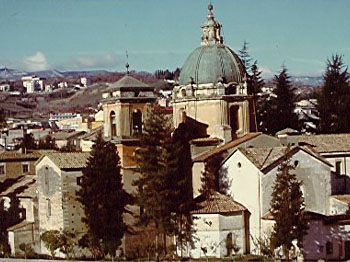
Our next stop is Crotone (ancient Croton). Dominated by its Castle and surrounded by sixteenth-century ramparts, it has retained the atmosphere of an aristocratic agrarian city, a homegrown ‘Nest of the Gentry', like Turgenev's novel transplanted to the south of Italy . The Achaean colony of Croton was under the ascetic rule of Pythagoras (his dietary recommendations designed to keep the body pure and the mind unclouded are still famous today). It witnessed the legendary sporting exploits of the athlete Milo , laid waste to Sybaris and welcomed Hannibal 's army. Evidence of its great and glorious past is still preserved in the Museo Archeologico ( Archaeological Museum ). The Duomo (Cathedral) has a venerated, Byzantine-style painting of the Madonna Nera (Black Madonna) di Capo Colonna. A flourishing municipal garden provides a pleasantly relaxing end to the tour.
old calabria recommends:
La Sosta, Via Corrado Alvaro
Tantissime le specialità marinare: dalla "rosa marina" (bianchetti fatti macerare nel peperoncino) alla frittata di bianchetti, ai bianchetti cotti nell'origano. Buona la scelta dei dolci. Ottimi i bignè con crema al limone e alla nocciola.
Gerardo Sacco Gioielleria Artistica, Via S. Paternostro
Tra i più noti artigiani orafi calabresi, famoso a livello internazionale per i gioielli ispirati alle antiche civiltà - greca, fenicia, romana - tutti realizzati con tecniche tradizionali.

Our next stop is Frascineto , which has a Museo delle Bambole in Costumi Albanesi ( Museum of Dolls in Albanian Costume), housed in a modern building. There are also numerous family-run wine-cellars to explore, however, and it's here that one really understands at first hand the proud solidarity of these communities, united by shared customs and memories and a great historical and commemorative tradition which all can acknowledge and share. Even the hospitality for which the Calabrian Albanians are famous stands up admirably to the test. Never have we met guides who were more willing or more generous with their time, as well as being keen to convey a positive image of their communities. Unfortunately, their villages are now very run-down and few traces of their artistic heritage remain: their real ‘cultural asset' is the oral tradition of dances, poems, ceremonies and songs which tell of their history and their faith.
old calabria recommends:
Ristorante Scanderberg, Via Arcuri 13
Piatti tipici della cucina tradizionale albanese, conditi con particolari olii d'oliva aromatizzati.
Museo delle bambole e del costume arberëschë, Via della Montagna
Il Museo del Costume di Frascineto rivaluta e diffonde la grandiosa manifestazione dell’identità albanese attraverso una ricca esposizione di costumi; esso si presenta diviso in due sezioni topologiche: gli albanesi nel Sud Italia e quelli in Albania, ed è caratterizzato dallo studio e dall’attenta analisi rivolta ad ogni minimo dettaglio relativo agli abiti ed ai costumi dell’etnia arbëreshë.
Contatti: museo@aquilareale.org - 349/10.73.220
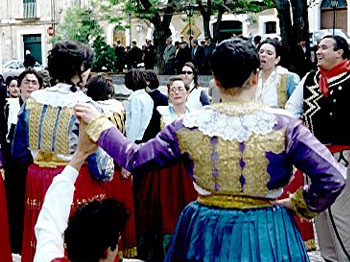
This is the name given to the imposing remains of a restored Aragonese castle, perched on a little island and looking out over a wonderful, boundless sea. Here there is still some of the atmosphere of a borderland. Le Castella, for example, saw the start of the incredible career of Giovan Dionigi Occhiali, known as Ucciali. A renegade, he was enlisted by the Turkish ‘enemy' at Istanbul and became admiral of the Ottoman fleet, ending up honoured with the title of Pasha of Tripoli and Tunis.

Our journey begins at Laino Borgo , a small, out-of-the-way place with a profusion of stone portals. Every house or small palazzo proudly displays its own carved version, with a small symbol at the top that serves as coat of arms. The fact that there are both old and more recent examples of these portals shows that the tradition is still alive today.
The village is famous for its ancient Good Friday mystery play, theGiudaica , which involves two hundred beautifully costumed performers. The production is attentive both to the theatrical nature of the performance and its religious significance. Water-sports facilities just outside the village on the River Lao introduce a discreet element of athleticism into these verdant natural surroundings, watered by murmuring streams. The Lao runs through a deep, wooded gorge, honeycombed with natural grottoes inhabited as early as Palaeolithic times. This is the heart of the legendary Byzantine monastic province ofMercurion , which was home to numbers of cave-dwelling ascetics.Laino Castello is perched high up on top of a hill. This tiny, abandoned village huddles around an imposing Lombard castle, which keeps an alert look-out over the valley. (It can be visited on request.)
old calabria recommends:
Centro Canoa & Rafting, a cura del Canoa Club Lao Pollino, Contrada Petroso - tel. 0981/85.735
Interessanti proposte di percorsi rafting e di torrentismo.
The village is built on the sides of sheer, grassy precipices. The old part huddles in the deepest cleft of a narrow valley and is reached by a circuitous descent that would have kindled the imagination of a Gustave Doré. The village of Longobucco was once famous for its silver mines and its grim and bloody resistance to Napoleon's troops. Nowadays it is the tranquil domestic tradition of hand-weaving which characterizes the place. Almost every house has an intricate old geometric loom, looked after as carefully as a musical instrument. These looms are used to weave wool, linen, silk, cotton and material made from strong, sweet-smelling broom. In the heart of the village stands the sixteenth-centuryChurch of Santa Maria , watched over by a squat campanile. Next door is the small Museo Civico (town museum), which has some fine Neapolitan silverware. The sparkling air and bustling streets give an air of gaiety to this small village hidden deep in the woods.
old calabria recommends:
Antica Bottega del tessuto d'arte di Mario Celestino, Via Monaci 14
Arazzi, coperte, tappeti e tovagliato fanno bella mostra di sé in questo piccolo ma mitico laboratorio. Tutto viene tessuto sul tradizionale telaio orizzontale secondo i disegni antichi. Bellissime le tele di ginestra.
L'Arte della Tradizione, Via Nazionale
È una società cooperativa costituitasi nel 1995. È composta quasi esclusivamente da donne, tutte esperte tessitrici. Bellissimi i manufatti realizzati, in prevalenza coperte, tutte tessute manualmente con telai e metodi di lavorazione rigorosamente artigianali.
Pub Pizzeria di Domenico Stella, Via Cristoforo Colombo 73
Ambiente rustico e di gusto. Ottimi gli antipasti, tutti rigorosamente a base di prodotti locali.
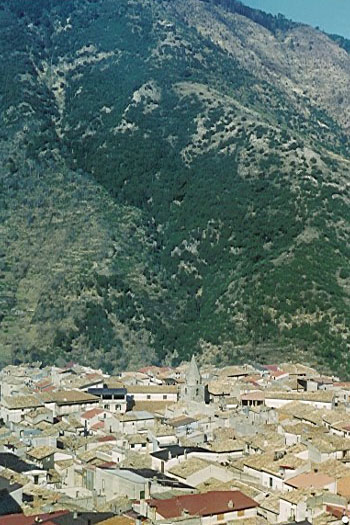
Heading back towards Castrovíllari, we stop at Lungro , a sprawling village greatly spoilt by the numbers of ugly half-finished buildings, but with magnificent mountain scenery all around. In San Nicola , the Greek Orthodox cathedral of the Albanian community, the eparch conducts services in Albanian and Greek. The mosaics and iconostasis are modern, the work of an icon-painter called Drobonicu, who lives in Lungro. The old salt mines ( miniere di sale ), which played a major role in the political and social history of Calabria, can no longer be visited – although the machinery and the long shafts dug out in the rock salt appear to be sufficiently well preserved to constitute a virtual seam of industrial archaeology in themselves.
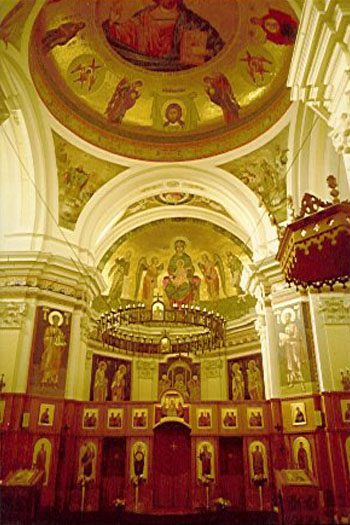
After leaving San Demetrio Corone, our ‘pilgrimage' takes in the tiny, out-of-the way village of Macchia . A beautiful old narrow mountain road winds up to the village, which feels as if it is hanging silently in the air. Here we can visit the modest stone-built house of Girolamo De Rada. This remarkable figure – bard, prophet and scholar – is the national poet and spiritual father of the Albanians of Calabria. We then rejoin a scenic local road – on either side, great expanses of olive trees cover the slopes which drop away as far as the eye can see. At the end of May, this road is thronged with pilgrims using every conceivable means of transport to reach the Church of Santi Cosma e Damiano .
old calabria recommends:
Centro Internazionale di Studi Deradiani, Corso Girolamo De Rada
A short stretch of motorway takes us to Morano Cálabro. Here the important thing is to get an overall view of the town: its urban layout is unusually regular, a geometric vision with something of an optical illusion about it. It inspired one of Escher's obsessive, dreamlike architectural compositions. The old quarter, perched high up around the remains of the imposing Norman-Swabian fortress, is extraordinarily well preserved. Here we need the energy of a mountaineer – the streets are so steep that it's a stiff climb up. To prepare ourselves, let us stop first at the foot of the village, next to the municipal gardens, in the fifteenth-century Church of San Bernardino : it has the customary coffered ceiling and a particularly fine wooden pulpit. A little higher up we come to the real entrance to Morano and the magnificent baroque Collegiata della Maddalena .The sacristy is also worthy of note: visitors will be astonished to find a polyptych by Vivarini, magnificent wooden choir-stalls, the throne, the great lectern and a beautiful statue by Gaggini.
On reaching the top of the village, we are rewarded for our exertions by the sight of the Church of Santi Pietro e Paolo . It stands next to the ruined fortress, which has now been turned into a grassy panoramic terrace. The church has four remarkable statues by Pietro Bernini, the father of Gian Lorenzo. From the flight of steps leading up to the church, there is a breathtaking view, falling sheer over the wide and rolling, intensively cultivated valley: a Flemish vista from the top of a Calabrian church! A little further ahead, it's time for the pleasures of the table after all this spiritual elation, as we stop in a sloping, tree-lined hortus conclusus belonging to a simple inn.
The church of the Convento dei Cappuccini (Capuchin convent), on the outskirts of the village, is worth a visit. It has the magnificent wooden furnishings which give Calabrian churches that special atmosphere of austere pomp – or, to put it another way, a naïf but elegant style that is typical of this out-of-the-way region with its disdain for passing fashions. The Museo dell'Agricoltura e della Pastorizia (Museum of Farming and Stock-raising), housed in simple, unpretentious premises in a primary school, is worth a visit – not only because of the quality and quantity of the items on show but also because of the intelligent way in which they are displayed. This is thanks to the museum's founder, Francesco Mainieri, a scholar with a passionate interest in the local countryside and its traditions. From Morano, hiking expeditions can be arranged in the Pollino National Park .
Centro Studi Naturalistici Il Nibbio
Vico Annunziata 11, near the Norman Castle.
old calabria recommends:
Hotel Ristorante Villa San Domenico, Via Sotto gli Olmi 15 - tel. 0981/30.588 fax 0981/30.409.
Piccolo albergo di charme, in pieno centro, in un antico palazzo ristrutturato. Venti le stanze disponibili. Da assaggiare il tortino di alici, il fagotto di gamberoni e il filetto alle erbe aromatiche.
La Cantina di Samuele Minervino, Piazza Croce 21 Tel. 0981 31034
Agriturismo - La Locanda del Parco Contrada Mazzicanino, 12 - 87016 Morano Tel. e fax 0981/31.304 e.mail: locandadelparco@libero.it
Società Cooperativa S.I.L.V.A., servizi per il turismo, tel. 0981/489.687 fax 0981/489.687.
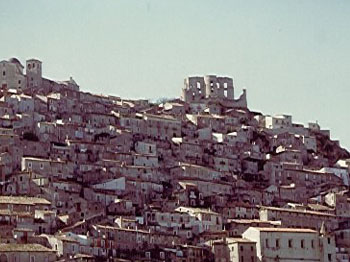
From Cosenza it is only a few minutes to Rende , with its unspoilt and admirably cared-for historic centre. The Mother Church of Santa Maria della Neve and the Church of Santa Maria di Costantinopoli are beautiful and well-maintained. There are also some fine palazzi such as the Palazzo Zagarese and Palazzo Vitari, which house, respectively, theMuseo Civico (town museum) and the Centro per l'Arte Contemporanea(Centre for Contemporary Art).
This small Calabrian town – well administered, hospitable and with some interesting cultural sights – is where we bring this concise but accurate account of our journey to a provisional end. It is up to you, dear traveller, to add detail to this bare outline of the Literary Park , sketched in your honour.
old calabria recommends:
Ristorante Pantagruel, Via Pittore Sant'Anna 2
Alloggiato in un antico palazzo cinquecentesco del centro storico, ristrutturato con gusto e cura del dettaglio, da cui si gode un bellissimo panorama. Offre gustose specialità a base di pesce. Da non perdere le tagliatelle (fatte a mano) con salsa di bianchetti. Ottima scelta di vini regionali.

From Cosenza it's a quick and easy walk to Rogliano , a sizeable village with a wealth of churches and palazzi belonging to the local nobility. It was the birthplace of patriots and illustrious prelates and has a long tradition of intellectual liveliness. Nowadays Rogliano is hoping for a revival and the village is keen to reappropriate its past. One laudable initiative is the setting up of a small Museum to house the ornaments and fittings rescued from an imposing Capuchin church and monastery, now abandoned. This treasure-house of Calabrian religious art contains reliquaries, carved altars of dark or dazzlingly gilded wood, finely embroidered and coloured vestments, engraved or embossed monstrances and ciboria, silver frames of the most exquisite eighteenth-century filigree work, religious paintings ranging from the austere taste of the Counter-reformation to charming naïf transpositions of sacre conversazioni to the interiors of humble dwellings, and so on. The museum has found a good home in the Church of the Spirito Santo , whose half-finished state merely adds to the charm. Rogliano's craft-workers are famous for their wooden and tufa carvings. They created the charming and supremely elegant church facades, as well as wooden ornaments for the interiors whose fine craftsmanship and perfect sense of proportion are a delight. The Church of San Pietro , which was redecorated towards the end of the nineteenth century, has a fin de siècle interior. From the ceiling down to the choir, the pulpit and the altars, the church is entirely covered in stucco of the most delicate pastel shades. Such a collection of decorative arts of the highest quality is a real treat for the keen traveller!
old calabria recommends:
Hotel Ristorante Ambrogio, Discesa Pietro Clausi 12 - tel. 0984/98.30.12 fax 0984/98.30.53
Club degli Amici di Rogliano Responsabile Dr. Francesco Piro, tel. 0984/961.02
Via Antonio Guarasci,184
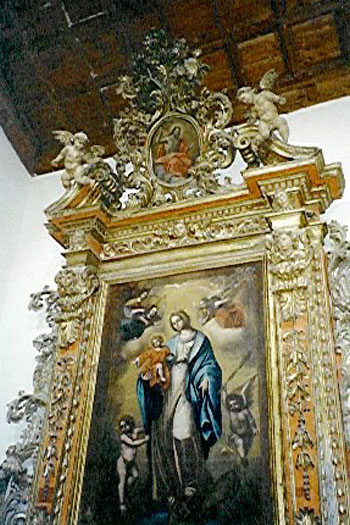
At Corigliano we start to sense the presence of nearby Rossano , the great centre for Basilian monks fleeing, first, from the disputes in Constantinople and subsequently from the Ottoman threat. This former stronghold of the Eastern Empire is famous for its image of the Madonna Acheropita, not painted by human hand (and therefore by the hand of angels); the miraculous life of San Nilo (St Nilus), one of the greatest figures of Orthodox spirituality; a magnificent bluish-purple illuminated Evangelistary, the work of Palestinian craftsmen; and, high up above the town, the Church of Santa Maria del Pátire , with its celebrated mosaic and the famous library whose contents were so shamefully dispersed. The particular charm of Rossano's lively and densely populated historic centre derives from its narrow streets, delectable patisseries and large numbers of splendid aristocratic palazzi, frequently still inhabited by the old noble families. The nineteenth-century buildings are impressive for their amplitude of design and generous use of space; the interiors, like palimpsests, record the changing tastes and decorative styles down the generations.
old calabria recommends:
Amarelli Fabbrica di Liquirizia, Strada Statale 106 Contrada Amarelli
Da più di 250 anni, la famiglia Amarelli lavora nella sua tenuta le radici di questa pianta benefica, producendo liquirizia di altissima qualità. Da visitare il Museo attiguo allo stabilimento ed il punto vendita , con un accattivante repertorio di prodotti.
Masseria Torre di Albidona, Contrada Piano della Torre, Trebisacce, tel.e fax 0981/50.79.44
Cucina e vino di ottima qualità. È possibile pernottare.
Cooperativa Neilos, servizi per il turismo, Piazza Duomo, 25 - tel.e fax 0983/52.52.63
e.mail: neilos@mediterranea-net.it
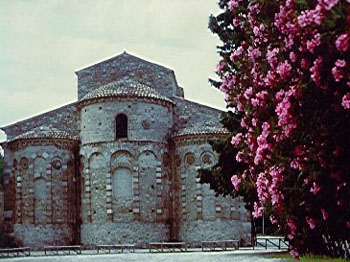
From Laino Borgo travel 30 kilometres along a pretty, winding road to the village of Rotonda , administrative centre of the Pollino National Park and situated in Basilicata (ancient Lucania). It's a neat, clean place with a bustling, friendly atmosphere, a lively but orderly piazza and a conveniently located car park. The streets leading off the piazza are lined with the handsome facades of elegant small palazzi. Every year on 13 June, Rotonda celebrates the feast of Sant'Antonio with its Festival of the Fir-tree, one of those pagan-sylvan festivals whose origins are lost in time.
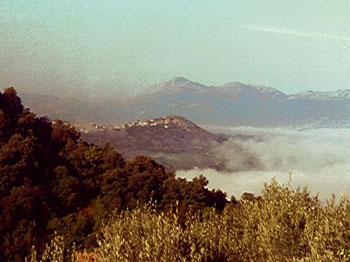
San Demetrio Corone , which still today has its Italo-Albanian College , of long and glorious tradition. Here the remarkable tenth-century Church of Sant'Adriano is like an anthology of Calabrian sacred art over the centuries, ranging from traces of the original Byzantine-Basilian construction to highly elaborate eighteenth-century decorative work.
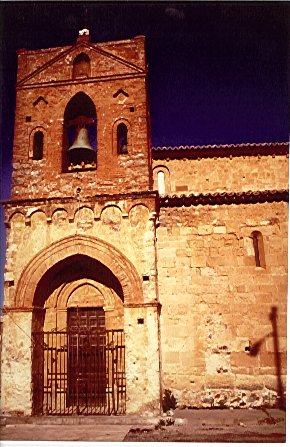
This ancient village, lost in reverie, seems motionless and frozen in time – one of those tableaux vivants that can still be found in the South. This is the starting-point for hikes in the Pollino National Park, graded according to difficulty and length.
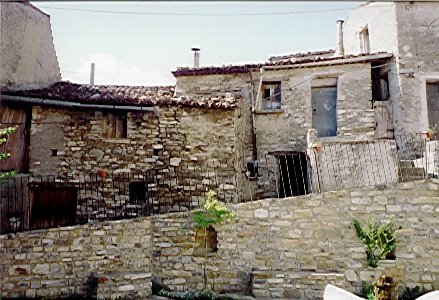
On the way we come across the bustling village of San Giovanni in Fiore , which stands on a steep hillside. Amidst the chaotic traffic, we find renowned goldsmiths' workshops and shops selling elegant textiles. The village is famous for the ‘saintly' monk Gioacchino da Fiore – prophet and visionary – who founded his principal monastery in this very spot in the twelfth century. In this inaccessible region, standing in haughty isolation, even the styles and forms of religion reflect harshness and severity rather than meekness and mercy. A hermit's life, abstinence and meditation, discipline of body and soul, contempt for the world together with the opposing desire to redeem it through radical reform: these were the strongest and most recurrent elements in Calabria's fervent religious life – admirably suited perhaps to a people living in a frontier region facing ‘the enemy'. Worth visiting are the early, much altered Badia Florense , with its Cistercian single-light windows and its seventeenth-century wooden choir-stalls; and the Museo Demo-antropologico , which houses objects and other evidence of the ancient peasant way of life, together with a remarkable collection of old documentary photographs.
Not far from San Giovanni in Fiore is the scenic Lake Ampollino . In these cheerful surroundings, it has no trace of that lacustrine melancholy so dear to sorrowful souls and unhappy lovers. On the contrary, the lake adds to the pleasant atmosphere and the overall ‘Swiss' appearance – but an unspoilt Switzerland before the advent of tourism! Crystalline air, far-off mists, scudding clouds, infinite expanses of green, garlands of trees and, every so often, a tiny patch of dark blue – these are the matchless elements that go to make up the great Silan watercolour!
old calabria recommends:
La Casella, Via delle Ginestre- tel. 0984/99.20.37
Per chi si trovi a San Giovanni in Fiore, la sosta a La Casella è d'obbligo, tanta è la sorpresa che suscita. E' una piccola casetta in pietra viva, restaurata con grande semplicità, appena fuori dal paese. Bella l'atmosfera, come pure l'ambientazione, che sembra ispirarsi alle locande dove si fermavano i viaggiatori del Grand Tour. Eccellente l'accoglienza e deliziosi i piatti proposti. Max quaranta i coperti. Si consiglia di prenotare.
La locomotiva, Contrada San Nicola Silvana Mansio 22 - tel. 0984/57.98.03
È un piacevolissimo punto-ristoro alloggiato nella vecchia stazione ferroviaria di Silvana Mansio, oggi utilizzata come sosta lungo il percorso del trenino a vapore da Cosenza a San Giovanni in Fiore. Nei vecchi vagoni della stazione dismessa, sapientemente restaurati, è possibile gustare i piatti tipici della tradizione silana (zuppe di legumi, pietanze a base di funghi, affettati).
Gioielleria Artistica Spadafora, Via Roma 3 - tel.0984/993.968 - 0984/990.883.
Tra i più noti artigiani orafi calabresi, famoso a livello internazionale per i gioielli ispirati alle antiche civiltà - greca, fenicia, romana - tutti realizzati con tecniche tradizionali.

By now we are in the historic Marchesato (marquisate) di Crotone , a fertile area formerly inhabited by a proud and warlike people. The first thing of beauty we come across is the dignified monumental piazza ofSanta Severina . This small town is proud of its Byzantine origins, its very early little churches that recall those of Armenia, the Cathedral with its coat of arms, the Baptistery with its purple-coloured font and antique granite columns, and the Castle (perhaps built by Robert Guiscard), which adds military pride to episcopal dignity. The beautiful, deserted piazza seems made for processions, parades and tournaments. Nowadays, with understated pride, it contents itself with welcoming travellers and passers-by, who stop there briefly to admire, while enjoying an icecream or an iced coffee. After this short pause for refreshment, we can visit the Museo Diocesano (Diocesan Museum), with its rich collection of church ornaments and vestments and sacred works of art.
old calabria recommends:
Azienda Agrituristica Le Puzelle, Contrada Puzelle, S.S. 107 bis
Alloggiata in un antico casale ristrutturato e arredato con gusto. Buona la cucina. Grande spazio all'aperto con piscina.
Proloco di Santa Severina "Siberene", Responsabile Prof. Antonino Pala, tel. 0962/51.598 fax 0962/51.055
Via N. D'alfonso, 1.
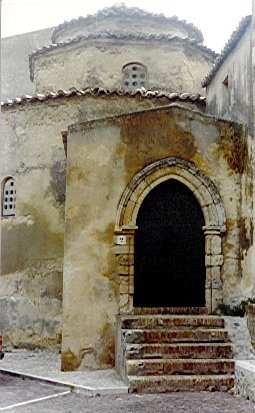
An Albanian village in the Greek Sila whose origins go back to c . 896; it has preserved the language and traditions of its ancient origins. The mother church, dedicated to Sant'Attanasio, is particularly interesting.
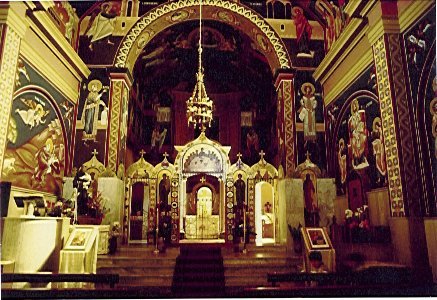
This time we are heading towards the Ionian Sea and the vast plain traversed by the River Crati (Crathis) where the ancient city of Sybarisonce stood. Almost nothing remains of Greek Sybaris – apart from the appealing legend of its refined customs, sophisticated tastes and enjoyment of douceur de vivre . The nineteenth-century archaeologist and writer François Lenormant wrote a brilliant, nostalgic account of Greek Sybaris which almost reconciles us to the complete disappearance of the ancient city. Here, the attraction for travellers is not so much the ruins and antiquities (Italy has grander and better-preserved sites), but rather the fascinating historical and philological reconstructions and the tales of the archaeologists who worked there – for the ‘restoration' of Sybaris also comes about through the power of words. Posterity has never indulged in the same nostalgic regret for the theocratic city of Croton (today's Crotone) – ruled by the puritanical and mystical aristocrat Pythagoras, and Sybaris' enemy and merciless conqueror – as for the beautiful Epicurean city of Sybaris. In ancient times, the plain of Sybaris was extremely fertile. It later became a malarial swamp, inhabited by herds of black buffalo and feverish, wan peasants. The land has now been reclaimed and is once again thriving – although the scenery has paid the inevitable price.

A lively village in the Sila, standing in a superb position looking out over Cosenza , in the upper valley of the Crati river. Its beautiful churches – San Biagio, San Pietro and San Francesco di Paola – have some magnificent examples of the Calabrian tradition of carved, inlaid and gilded wood.

The charming and beautifully kept little village of Vaccarizzo . All these austere mountain villages have what might be described as a wary, slightly bewildered air; they seem almost untouched by the chaos of the real world. The fact that they appear ‘suspended in time', together with the old-world courtesy of the inhabitants, gives them their particular charm.
A place of great natural beauty, with wonderful views. Visitor attractions include endless grottoes, alabaster quarries and a hot sulphur spring.
old calabria recommends:
Gruppo Speleologico Le Grave, servizi per il turismo, Via Regina Margherita, 52 -
Tel. 0962/76.30.93 - 0962/76.33.14 - 0962/76.30.58.
proviamo quella grata sensazione che non va mai disgiunta dal compimento di una faticosa impresa ...
la purità dell'aria, il baglior della luce, non mancano di elevar lo spirito alle più
sublimi considerazioni.
M. Tenore
Viaggio in alcuni luoghi della Basilicata e della Calabria Citeriore, 1826
From Rotonda, a high mountain road leads to Viggianello , its misty outline silhouetted hazily against the sombre backdrop of the mountain peaks. The air is sparkling, there are few sounds of activity to disturb the silence and the passers-by, wrapped in their black clothes, blend perfectly with the natural austerity of the place. The verdant valleys beckon invitingly way down below the steep and craggy slopes. The facades of the buildings are plain, with a liberal use of skilfully worked stone; the low doorways afford glimpses of small cobbled entrance halls given a splash of colour by the little flowering plants they shelter and fine, solid stairways that one is tempted to describe as ‘cyclopean'. Slightly below and to one side of the village in a prominent position stands a stark, proud castle, like those which Manzoni compares to eagle's nests in his novel, I Promessi Sposi .
We leave Viggianello and set off ‘on a pilgrimage' for the Santuario(shrine) della Madonna del Pollino.
old calabria recommends:
Hotel Ristorante La Locanda di San Francesco, Via San Francesco 4
Alloggiato in un antico palazzetto restaurato di recente, dispone di venti camere, molte delle quali con bellissima vista panoramica sulla vallata.

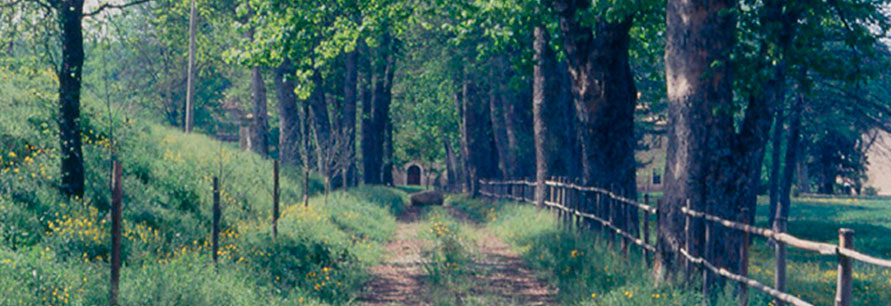
Our journey through the Old Calabria Literary Park is imbued with the spirit of Norman Douglas' great book of the same name. We were overjoyed to find the same magnificent mountains and scenery, the same remote and high-perched villages, that so excited him (perhaps in part because certain features of the three Silas reminded him of the views and atmosphere in the Scottish Highlands.) Such was Douglas ' enthusiasm that he returned to Calabria several times on his walking tours, accompanied by young lads, like the heroes and sages of ancient Greece .
With our love of footpaths and sudden scenic views, we have decided to visit the mountains of the Pollino massif and the three divisions of theSila (the Sila Greca, the Sila Grande and the Sila Piccola). These jagged peaks are swathed in magnificent vegetation and watered by innumerable springs, torrents, lakes and fiumaras – an aquatic symphony whose notes range from silvery tones to a deep, thunderous roar.
All rights reserved: photographic archive, texts and translations.
ALL RIGHTS RESERVED, ARCCORDING TO INTERNATIONAL LAWS AND CONVENTIONS.
Nessun materiale può essere riprodotto senza autorizzazione.
Fondazione Napoli Novantanove | Tel. 081/66.75.99 | Fax 081/66.73.99 | Via Martucci, 69 – 80121 Napoli | P.IVA 04506300633